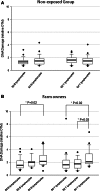DNA damage in B and T lymphocytes of farmers during one pesticide spraying season
- PMID: 25647545
- PMCID: PMC4564440
- DOI: 10.1007/s00420-015-1024-3
DNA damage in B and T lymphocytes of farmers during one pesticide spraying season
Abstract
Purpose: The effect of one pesticide spraying season on DNA damage was measured on B and T lymphocytes among open-field farmers and controls.
Methods: At least two peripheral blood samples were collected from each individual: one in a period without any pesticide application, several weeks after the last use (January, at period P0), and another in the intensive pesticide spraying period (May or June, at period P4). DNA damage was studied by alkaline comet assay on isolated B or T lymphocytes.
Results: Longitudinal comparison of DNA damage observed at both P0 and P4 periods revealed a statistically significant genotoxic effect of the pesticide spraying season in both B (P = 0.02) and T lymphocytes (P = 0.02) in exposed farmers. In contrast, non-farmers did not show any significant modifications. DNA damage levels in B and T lymphocytes were significantly higher in farmers than in non-farmers during the P4 period (P = 0.003 and P = 0.001 for B and T lymphocytes, respectively) but not during the P0 period. The seasonal effect observed among farmers was not correlated with either total farm area, farm area devoted to crops or recent solar exposure. On average, farmers used pesticides for 21 days between P0 and P4. Between the two time points studied, there was a tendency for a potential effect of the number of days of fungicide treatments (r (2) = 0.43; P = 0.11) on T lymphocyte DNA damage.
Conclusions: A genotoxic effect was found in lymphocytes of farmers exposed to pesticides, suggesting in particular the possible implication of fungicides.
Keywords: Comet assay; DNA damage; Lymphocytes; Occupational exposure; Pesticides.
Figures


Similar articles
-
DNA damage in mononuclear leukocytes of farmers measured using the alkaline comet assay: discussion of critical parameters and evaluation of seasonal variations in relation to pesticide exposure.Cancer Epidemiol Biomarkers Prev. 1998 Oct;7(10):917-27. Cancer Epidemiol Biomarkers Prev. 1998. PMID: 9796638
-
DNA damage in mononuclear leukocytes of farmers measured using the alkaline comet assay: modifications of DNA damage levels after a one-day field spraying period with selected pesticides.Cancer Epidemiol Biomarkers Prev. 1998 Oct;7(10):929-40. Cancer Epidemiol Biomarkers Prev. 1998. PMID: 9796639
-
A longitudinal follow-up study of oxidative stress and DNA damage among farmers exposed to pesticide mixtures.Environ Sci Pollut Res Int. 2019 May;26(13):13185-13194. doi: 10.1007/s11356-019-04650-z. Epub 2019 Mar 21. Environ Sci Pollut Res Int. 2019. PMID: 30900128
-
Comet assay for assessment of DNA damage in greenhouse workers exposed to pesticides.Biomarkers. 2019 Sep;24(6):592-599. doi: 10.1080/1354750X.2019.1610498. Epub 2019 Jun 21. Biomarkers. 2019. PMID: 31020853
-
Occupational exposure to pesticides: Genetic danger to farmworkers and manufacturing workers - A meta-analytical review.Sci Total Environ. 2020 Dec 15;748:141382. doi: 10.1016/j.scitotenv.2020.141382. Epub 2020 Aug 7. Sci Total Environ. 2020. PMID: 32818891 Review.
Cited by
-
Land use as an effective factor on the occurrence of chromosomal diseases in Brazil.Int J Mol Epidemiol Genet. 2021 Oct 15;12(5):102-111. eCollection 2021. Int J Mol Epidemiol Genet. 2021. PMID: 34853634 Free PMC article.
-
Cell resistance to the Cytolethal Distending Toxin involves an association of DNA repair mechanisms.Sci Rep. 2016 Oct 24;6:36022. doi: 10.1038/srep36022. Sci Rep. 2016. PMID: 27775089 Free PMC article.
-
Agricultural exposures and DNA damage in PBMC of female farmers measured using the alkaline comet assay.Int Arch Occup Environ Health. 2024 May;97(4):353-363. doi: 10.1007/s00420-024-02049-z. Epub 2024 Mar 2. Int Arch Occup Environ Health. 2024. PMID: 38430240 Free PMC article.
References
-
- Bolognesi C, Landini E, Perrone E, Roggieri P. Cytogenetic biomonitoring of a floriculturist population in Italy: micronucleus analysis by fluorescence in situ hybridization (FISH) with an all-chromosome centromeric probe. Mutat Res. 2004;557:109–117. doi: 10.1016/j.mrgentox.2003.09.013. - DOI - PubMed
Publication types
MeSH terms
Substances
LinkOut - more resources
Full Text Sources
Other Literature Sources
Medical

